Report
by Kathleen Horner
- Published: Friday, July 05 2013 07:08
"The shadow of my finger cast,
Divides the future from the past.
Before it, sleeps the unborn hour.
In darkness, and beyond they power.
Beyond its unrelenting line,
The Vanished hour, no longer thine.
One hour alone in they hands...
The NOW on which the shadow stands."
-- Henry Van Dyke
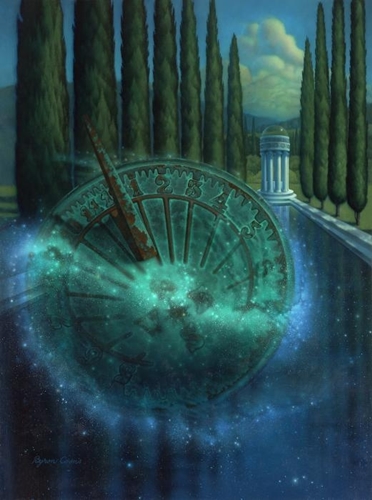 Brigit Bryan Coons, Artist
Brigit Bryan Coons, Artist
In July's Astronomers Without Borders AstroCraft project we will be discussing sundials and sharing several different patterns and creative ideas on how to make your own sundial. Again, these learn and create craft projects are geared for all ages. Perhaps you'll even become inspired to create your own sundial design! Sundial patterns included in this article range a simple paper and cardstock sundials, flower dials, sand and shells sundial to the Planetary Society's EarthDial and MarsDial with a colorful introduction by the Science Guy, Bill Nye.
Brief History of Sundials
The sundial is the oldest known device for the measurement of time and the most ancient of scientific instruments and goes back to 5000-3500 BC. How did we first learn to measure time? The division between day and night was obvious to the early peoples. They also knew that the sun would rise from the East and set in the west bringing about nighttime. Shadows cast across the ground would grow from long in the early morning to very short at mid-day and then grow long again as sun set in the west. The first device for indicating the time of day was probably the gnomon. It consisted of a vertical stick or pillar; the length of the shadow it cast gave an indication of the time of day. The vertical shadow stick is the earliest form of sundial. People judged the time of day by the length and position of the stick's shadow. The technical name for a shadow stick is gnomon,(NO mon) which is Greek for "the one that knows". The Greek historian Herodotus (484-425 BC) stated that sundials originated with the ancient Chaldeans and Sumerians who lived in Iraq. They used vertical rods on their buildings to cast shadows in order to tell the time and the date, and were the first people to divide the day into 24 hours, the week into seven days and the year into 12 months.
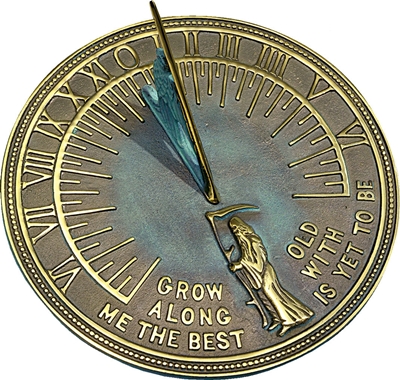
How Do Sundials Work?
As the earth turns on its axis, the sun appears to move across the sky. The shadows the sun casts move in a clockwise direction for objects in the northern hemisphere. If the sun rose and set at the same time and spot on the horizon each day shadow sticks would have been accurate clocks. However, the earth is always spinning like a top. It spins around an imaginary line called its axis. The axis runs through the center of the earth from the North Pole to the South Pole. The earth's axis is always tilted at the same angle.
Every 24 hours the earth makes one complete turn, or rotation. The earth rotates on its axis from west to east. The earth's rotation causes day and night. As the earth rotates, the night side will move into the sunlight, and the day side will move into the dark.
On the earth's yearly trip around the sun the North Pole is tilted toward the sun for six months and away from the sun for six months. This means the shadows cast by the sun change from day to day.
Because the earth is round, or curved, the ground at the base of a shadow stick will not be at the same angle to the sun's rays as at the equator. Because of this the shadow of the shadow stick will not move at a uniform rate during the day.
Eventually humankind discovered that angling the gnomon and aiming it north made a more accurate sundial. Because its angle makes up for the tilt of the Earth, the hour marks remained the same all year long. This type of gnomon is called a style. After this discovery, people were able to construct sundials that were much better at keeping accurate time.
---
Simple Cardstock Sundial (Northern Hemisphere)
The image below is of a basic cardstock sundial I created from a printable pdf file. It was about 1:47 PM so you can see that the sundial was giving the correct time. You can find the directions on how to make this one at this link:
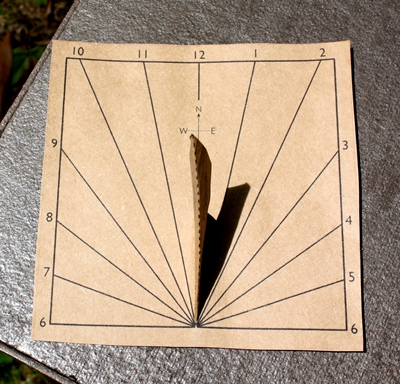 Link: http://www.rmg.co.uk/make-your-own/sundial
Link: http://www.rmg.co.uk/make-your-own/sundial
Garden Sundial
Here's a really colorful way to keep time out in the yard. Find a spot in your yard where it's sunny all day and create this beautiful garden sundial. This would be a great project for children, too! You can find those little plastic plant pots everywhere plus you can make your own plant pots from large cans and milk cartons. You can grow herbs, flowers, or vegetables or mix them all together for a really unique sundial garden. Check out this link thanks to Nancy Ondra from Home and Garden Television network.
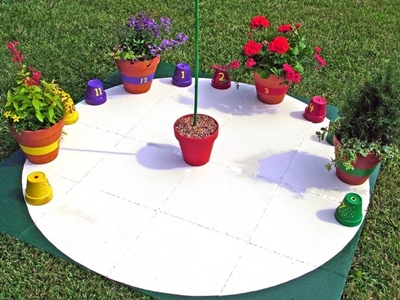 Link: http://www.hgtv.com/gardening/how-to-make-a-garden-sundial/index.html
Link: http://www.hgtv.com/gardening/how-to-make-a-garden-sundial/index.html
Ground Sundial
This is a sundial you can create anywhere even at the beach. All you need is a stick and pebbles, shells or other found objects from nature. It is most likely that the ancient peoples kept track of time this way. Group fun with this one!
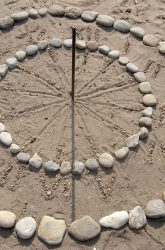 Instructions and ideas by Jessica McBrayer at Education.com.
Instructions and ideas by Jessica McBrayer at Education.com.
Linkd: http://www.education.com/activity/article/Make_Sundial/
Southern Hemisphere Simple Paper Sundial
The clock that we use today was originally developed from the sundial, which used the sun to cast a shadow that would tell what the time was. In fact, before clocks had become popular the term wasn’t “clockwise,” it was “sunwise,” because that’s the way the rotation went.
However, had the sundial been developed in the Southern Hemisphere, our clockwise may very well have moved counterclockwise. The reason for this is simple. A sundial must be placed southward in the Northern Hemisphere to function correctly. When the sun rises in the sky east to south to west, the shadow that is projected moves in the opposite direction, west to north to east, or clockwise.
This is why when developing modern clocks inventors simply made the hands move in the same direction. If a sundial is placed in the Southern Hemisphere however, the motion is reversed and the clock would spin counterclockwise!
Link: http://www.skyandtelescope.com/letsgo/familyfun/Make_Your_Own_Sundial.html
Beautiful Cardstock Sundial for Southern and Northern Hemispheres

Sundial Printed Pattern (Image Above)
Print out the color sundial pattern: http://cp.c-ij.com/en/contents/3151/sundial/downloads/sundial_e_a4.pdf
How to assemble above pictured sundial: http://cp.c-ij.com/en/contents/3151/sundial/downloads/sundial_i_e_a4.pdf
Paper Plate Sundial For Very Young Children
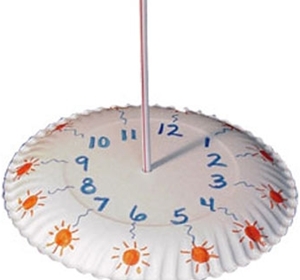
This is an easy one for very young children and they will learn the basics of how a sundial works with the movement of the Sun across the sky. Link: http://www.nwf.org/kids/family-fun/crafts/sundial.aspx
How to Make a MarsDial and EarthDial (Southern and Northern Hemispheres)
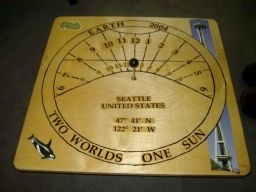 The Earth Dial (photo above)
The Earth Dial (photo above)
Compliments from the Planetary Society and introduced by the Science Guy, Bill Nye. These designs are a little more involved, but there are colorful printed patterns that you can use to construct the two dials plus there are templates for all locations in the world. I can't wait to get started on my MarsDial! Here is the link to make a MarsDial: http://www.planetary.org/explore/projects/earth-dial/instructions.pdf
How to make an EarthDial: http://www.planetary.org/explore/projects/earth-dial/instructions.html#i
---
That's it for this month's AstroCraft project. Again we encourage you to share your photos of any AstroCrafts designs that you may have created and post them on the Astronomers Without Borders photos gallery page. Enjoy experimenting with the sundials and I'll be back in August with another unique AstroCraft project!
###
My Recent Reports
Contact
| Location: | Sri Lanka  |
|---|---|
| Website: | thilinaheenatigala.blogspot.com |







Comments